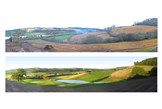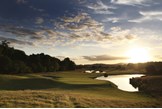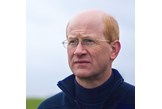Q&A with Ryder Cup course designer
Published: Last updated:
Nobody knows Celtic Manor’s Twenty Ten course more or better than Ross McMurray – he designed it! Here he gives an intriguing insight into the layout that will seriously test Europe and America’s finest next month.
Question) How did you get to design the course for the 2010 Ryder Cup?
RM: In 1999 European Golf Design was asked by Celtic Manor Resort to look at the possibility of building a golf course specifically for what was to be the 2009 Ryder Cup. Our MD, Jeremy Slessor, had previously worked at The Celtic Manor Resort on the construction of the Roman Road Course so there was already a connection with the people there.
We looked at a lot of land parcels and options and eventually, after many different routing studies, I came up with a scheme whereby nine new holes would be designed to fit in with nine retained holes from the Robert Trent Jones II Wentwood Hills Course.
Q) Obviously there are certain design principals you must always follow but were there any key issues that were special to this course?
RM:The Twenty Ten Course wasn’t to be just a tournament course. It was a course for the Ryder Cup, which brings a lot of different factors into the equation. Issues like locations for corporate hospitality, space for tented villages and media centres and spectator viewing become far more important. For instance, at a Ryder Cup you might get 50,000 people watching only four matches at any one time over the first two days.
We had to think about how these people would move around the site and give them every opportunity to see as much golf as possible, particularly over the last few holes where the excitement is reaching its peak. With the Twenty Ten Course we were able to route the last three holes along the edge of a hillside, which allowed us to create huge viewing areas on the high side of these golf holes.
An example of how the Ryder Cup impacts on the routing of a golf course would be the location of the 1st tee. I looked at positioning the 1st tee complex at the bottom of the hill, across the road, but much closer to the clubhouse than it is now.
But, in discussions with the Ryder Cup Staging Department, I quickly realised that this would effectively cut off the tented village from one of the main access points, so I pushed the tees right over to the river and made it a right-to-left-dog-leg instead of a left-to-right. This freed up an enormous area which, during the Ryder Cup, is being used not only for the tented village, but also for the huge media centre.
For the rest of the time this area is the Twenty Ten practice area. All this, then, required a second practice area to be built on the other side of the river Usk which had to be connected to the course with a new bridge.
Q) In what ways did the strategic design for this course differ from any other course you have designed?
RM:On many of the new holes I tried to introduce plenty of variety in the way the holes can be set up and played, allowing them to be adapted to better suit the format, whether it be foursomes, fourballs or singles.
For instance the 5th hole can be played at about 450 yards from the back tee or it can be made into a dramatic, short par 4 where you have the opportunity to almost drive the green across the water.
Whichever tee is used though, there are a number of options for the drive. Holes like the 14th require similar decisions on the tee but many holes offer gambling opportunities of varying degrees, whereby players can gain an advantage by taking on a more difficult tee shot. I think the Twenty Ten can be a classic matchplay course.
Q) You mentioned that nine of the holes were retained from the Wentwood Hills Course. What work, if any, was done to these holes?
RM:After we had completed the work on the new holes it was agreed that all the bunkers on the old holes would need to be changed so that the styles matched. My role was to make recommendations on bunker shapes in general and also suggest locations for any new bunkering to improve strategy. In all seven new fairway bunkers were installed on holes 9, 11 and 15.
A new back tee was installed on the 12th and the 11th green surrounds have been reshaped following a suggestion by Colin Montgomerie to toughen up the pin positions on this short par 5.
There have been some alterations to the set up of the course with fairway mowing outlines and so on, but apart from being returfed and the correction of some surface drainage issues, none of the greens or fairways have been reshaped on any of the holes from the original Wentwood Hills Course.
Q) Did the decision to use holes from the old Wentwood Hills Course impact on your design style.
RM:If you are retaining holes from an existing course, you don’t have carte blanche to do whatever you want with the new holes. I couldn’t go crazy with the design of the new greens, for instance.
It was important to me to ensure that the character of the new holes tied in to the retained holes without a noticeable clash of design styles. I was adamant that bunkers on the retained holes needed to be more penal.
The bunkers on the new holes were made deeper and we rolled the grass down the faces further, partially to soften their visual impact on the landscape.
The Twenty Ten Course moves through three subtly different landscape characters. The first five holes are new and fairly tightly enclosed and so the mounding naturally feeds into the fairways creating slightly more movement. Between the 6th and 14th (where the majority of the old holes are) the landscape is much broader in scale with many of the holes playing around lakes or along the River Usk and so the flatter nature of the golf course reflects this character.
Finally, you have the last four holes which play across the hillside, which naturally have a different feel, but hopefully it is all tied together by consistent course design.
Q) What were the main challenges in doing the 2010 course at Celtic Manor?
RM:Trying to balance the needs of a wide range of different consultants and other interested parties including Celtic Manor Resort, the various statutory bodies and the European Tour and their staging department.
On top of that, there was input and advice from engineers, ecologists, archaeologists, The Ryder Cup Committee and a number of others such as former Ryder Cup captain Brian Huggett and latterly Colin Montgomerie. In terms of the design, and even though we were effectively building only nine holes, it was probably the most complicated project I have worked on and required a huge number of design revisions even during construction.
Probably the biggest difficulty we had to overcome was the archaeology. While we had a good idea of where the most sensitive historic areas were (parts of the site were designated as Scheduled Ancient Monument), it wasn’t until the archaeologists had carried out their geophysical tests backed up by excavations that we realised the full impact. Consequently, even as the construction work was starting, we had to make major revisions to the 17th hole, converting it from a par 4 to a par 3, and making the course a par 71.
The handling of drainage and flooding was another major issue. There were three main factors: potential flooding from the River Usk, high ground water levels, and natural drainage gathering in the base of the valley.
We solved some of these by taking all the excavated material from the 16th, 17th and 18th (about half a million cubic metres) and using it to build an earth bund along the river and to raise the flat valley floor.
We then shaped the fairways to direct surface water into drainage gullies and backed this up with an extensive sub-surface drainage system beneath the soil. Celtic Manor Resort also provided additional investment to allow equal quantities of sand to be mixed with the on-site topsoil to improve the drainage properties of the soil even further.
Q) How many marks would you give the course out of ten. In other words, how pleased and proud are you of your handiwork?
RM:I couldn’t possibly rate it like that. I can say I’m absolutely delighted with the way it has come out. I’m particularly pleased now that Jim McKenzie and his team have done such a great job in getting the golf course to play as we had intended, especially with all the run offs around the greens, and it was good that Colin Montgomerie was just as keen to develop these areas.
I enjoyed seeing the impact of the firm greens and quick surrounds on the playability of the course at this year’s Celtic Manor Wales Open. I have to say I think it is a very fair course.
There’s nothing hidden from the golfer and it doesn’t need to be tricked up in any way.
Q) As you are doing your work do you ask colleagues to have a look or do you wait until the project is finished and then sit back while they lay into it?
RM:European Golf Design has four other designers and we all share ideas and problems. It would be madness not to. Mind you, it doesn’t stop them giving you stick when they feel you deserve it and if you get on your high horse you’ll soon come down with a bump, which is just as it should be.
But where we’d all really be lost is if we didn’t have the help of our production department. For this project Matt Sturt, Alex Hay and Will Dodgin were the real stars, constantly having to produce new plans after the redesigns, often at a moment’s notice, even creating fly-throughs of the golf course for the Ryder Cup bid presentation, so everyone could understand what was going to be created.
Q) Colin Montgomerie had some input into the golf course in his role as Ryder Cup captain. What were the things he was particularly keen on?
RM:I’ve already mentioned his support in developing the run-offs around the greens, but there are also plenty of places where he was happy for the rough to be brought closer to the putting surfaces as well.
Colin suggested areas where he felt the fairways could be tightened and we looked at the ways different holes could be played and which tees might be used at the Ryder Cup.
These were all then tested during the last two Celtic Manor Wales Opens. Probably his biggest input on the golf course design was on the 11th, the shortish par 5 retained from the Wentwood Hills Course.
We had already installed a new bunker at the front left of the green but Colin was keen that this side of the green was made more penal and suggested that we raised the face of the bunker and cut out a swale on that side between the putting surface and the water. This should provide some much tougher left side pin positions, especially for anyone who lays up short of the green with their second.
Q) Do you have a golf course architectural hero? What is the overriding thing he did that influenced you?
RM:I’ve been influenced by a whole variety of different designers and golf course styles. There are always things you can learn whether it’s to do with strategy, maintenance, engineering or looking at circulation issues around greens and tees. You can often learn as much from poor design as good design.
But the one thing I determined sometime ago was to do it my own way, don’t try and copy any particular style and don’t force a design style onto a piece of property.
It is strange though how many of the courses that I particularly like (courses such as Gleneagles and Carnoustie) have been designed, or have a connection with James Braid, who I wouldn’t rank as one of the top ten designers of all time!



